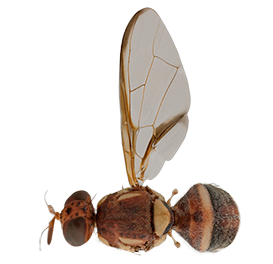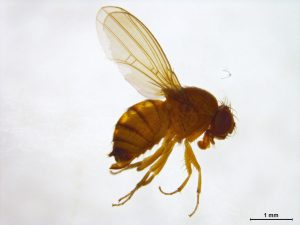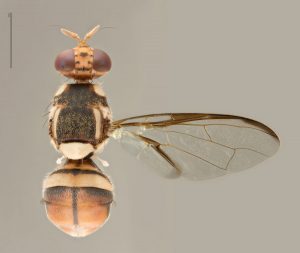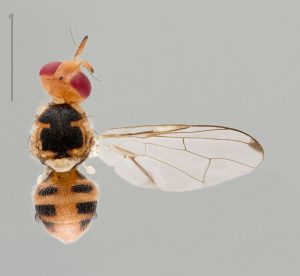IDENTIFYING FRUIT FLY
Adult Queensland fruit fly are typically about 7 millimetres long and are reddish-brown in colour, with distinct yellow markings.
Fruit fly are often not discovered until fruit is cut open and a visual inspection detects creamy – white maggots burrowing inside.
Other indicators of fruit fly activity include the detection of small puncture marks or stings on the skin of fruit. These marks are left from female fruit fly after the laying of eggs and prematurely ripen fruit.
The fruit fly’s rapid breeding cycle can lead to significant population growth over a short period. There are four stages in the fruit fly life cycle: egg, maggot (larva), pupa and adult fly.
EXOTIC PEST FRUIT FLY
While Victoria is free from these exotic pest fruit flies, increased awareness of the potential threat they pose is important in protecting the region.
Awareness is recommended around the following exotic pest fruit flies:
Mediterranean fruit fly [Medfly] (Ceratitis capitata)
Not present in Victoria. This pest also attacks most fruit and fruiting vegetables. It has established populations in several regions of Western Australia and there are periodic outbreaks in South Australia each year recently, which means that Victoria is at high risk. For more information on Medfly visit the Agriculture Victoria website.
Spotted wing drosophila (Drosophila suzukii)
Not present in Australia. Attacks all berries (including grapes) and most pome and stone fruit. This pest has recently left its homelands in north- east Asia and spread to many parts of the world. For more information visit the Plant Health Australia website.
Oriental fruit fly (Bactrocera dorsalis)
Not present in Australia. Attacks more fruits and vegetables than Qfly and Medfly and is a major impact pest. This pest has spread into many regions around the world recently invading Italy and France. For a general discussion on exotic pest fruit flies visit the Australian Government’s Department of Agriculture Water and Environment website.
Olive fly (Bactrocera oleae)
Not present in Australia. The olive fly is the number one pest in olives grown around the Mediterranean. It has invaded and established in the USA and is highly invasive. For more information on Olive fly click here.
For more information about Agriculture Victoria’s Fruit Fly Strategy 2021-2025 visit the Agriculture Victoria website.


Medfly (photo credit: Plant Health Australia)

Spotted wing drosophila (photo credit: Plant Health Australia)

Oriental fruit fly (photo credit: Plant Health Australia)

Olive fruit fly (photo credit: Plant Health Australia)
Agriculture Victoria developed the following video about about the life cycle of Queensland fruit fly, how it spreads, and how to monitor fruit and vegetables for signs of infestation and control numbers.
